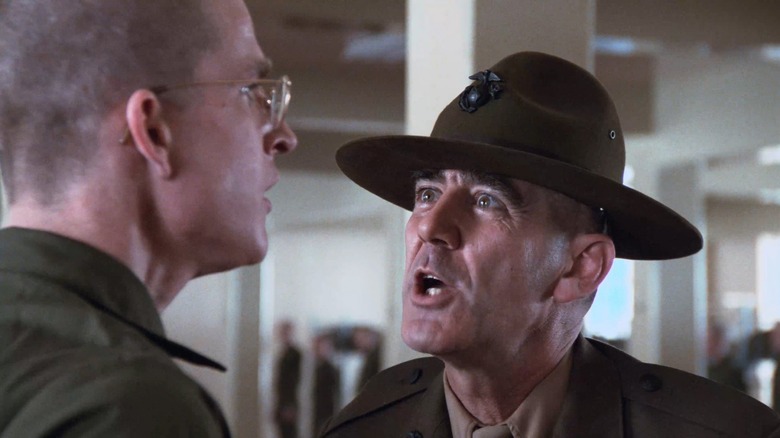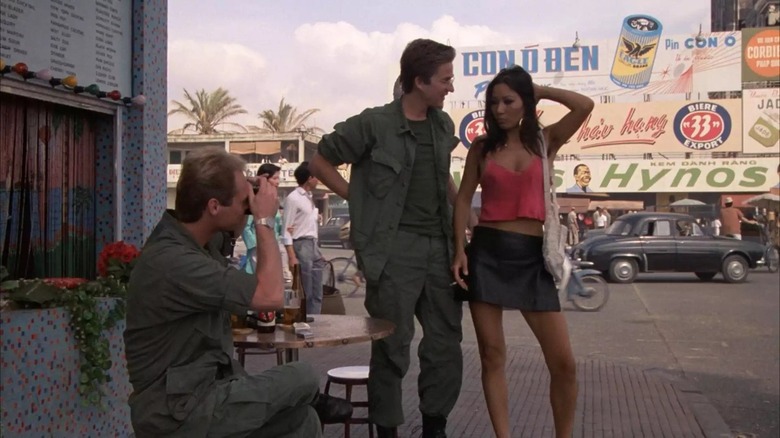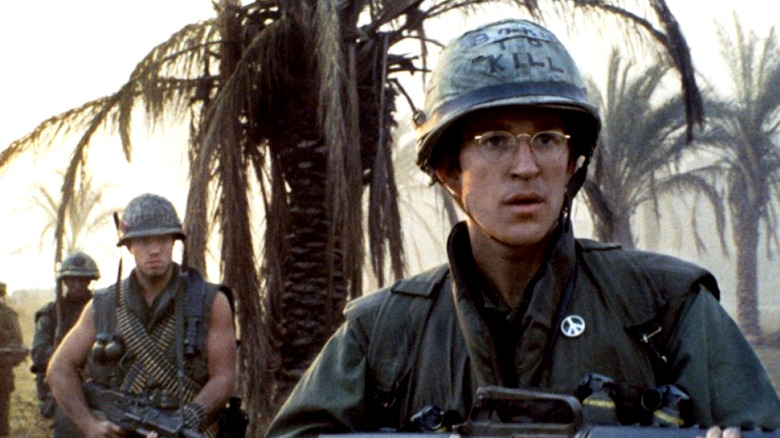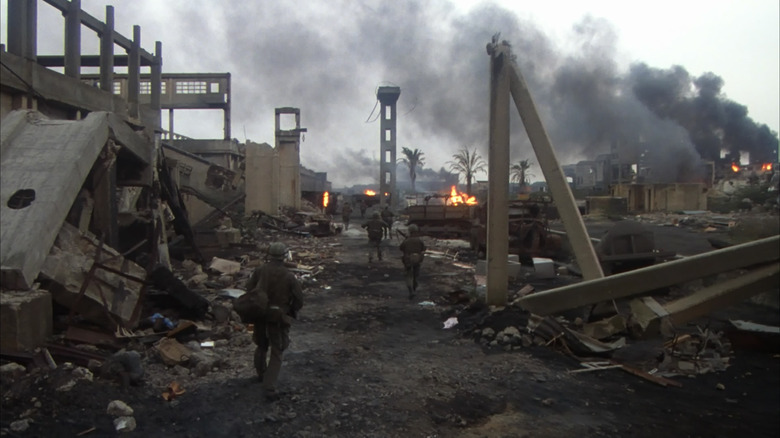Full Metal Jacket's Set Design Relied On A Wrecking Ball And A Lot Of Explosives
September 7, 1940, was a beautiful warm day in London, with many people enjoying the fine weather (via Newham Photos). That all changed around teatime when the air raid sirens wailed and over 300 German bombers, supported by over 600 fighter planes, swarmed over the city. One of their main targets was the industrial hub in the East End and Docklands, and the sprawling Beckton Gas Works was hit with high explosives and firebombs.
By the time the all-clear sounded around dawn the next morning, 146 people had lost their lives. That day became known as "Black Saturday" and marked the beginning of the Blitz, with another 56 consecutive nights of bombing rocking the capital. After the war, the Beckton site underwent a huge reconstruction project and became one of the largest gas works in the world until its closure in 1976. Then, over 40 years after the Luftwaffe tried to level it, an American director named Stanley Kubrick arrived to blow it up again, albeit for more creative purposes this time.
When it came to recreating Vietnam in the late '60s for "Full Metal Jacket," Kubrick turned to his adopted homeland in the United Kingdom, where the Bronx native had emigrated in 1961. The sedate Norfolk Broads doubled for the Mekong Delta, while the scenes set in a Marine Corps Recruitment Depot in South Carolina were shot at Bassingborn Barracks in leafy Cambridgeshire (via The Cinemaholic).
Beckton Gas Works took center stage for the film's climactic battle scene, doubling for the bombed-out city of Huế 6000 miles away. Although the site was already abandoned and falling into ruin, it still required a few heavy-duty modifications to fully look the part.
So what happens in Full Metal Jacket again?
"Full Metal Jacket" opens with new recruits arriving for training in the Marine Corps during the Vietnam War, where they are given a free haircut and introduced to the inventive verbal and physical abuse of their drill instructor, Gunnery Sergeant Hartman (R. Lee Ermey). His methods are harsh and relentless, and he wastes no time giving his new charges nicknames. Quick-witted J.T. Davis (Matthew Modine) becomes "Joker" after unwisely doing a John Wayne impression in the middle of Hartman's introductory rant, while the out-of-shape Leonard Lawrence (Vincent D'Onofrio) is dubbed "Gomer Pyle" after the hapless character on "The Andy Griffith Show."
Pyle doesn't really seem cut out for life in the Marines and is the primary focus of Hartman's rage. Although he starts making progress after being paired with Joker, the other recruits turn on him when Hartman starts punishing all of them for every mistake Pyle makes upon finding a donut hidden in Pyle's footlocker. Pyle eventually snaps and shoots Hartman dead before turning his rifle on himself.
The second half of the film finds Joker based in Da Nang, Vietnam, where he writes for a military newspaper for the troops and hangs out with his friend Rafterman (Kevyn Major Howard), a combat photographer itching to see some action. He soon gets his wish when he and Joker find themselves part of the Battle of Huế, a long and brutal attempt by American and South Vietnamese forces to recapture the territory. The city is already in smoking ruins by the time they arrive, but there is still much danger hidden among the rubble.
How Kubrick turned a gas works into a warzone
The first time I saw "Full Metal Jacket," I found myself distracted by the location stuff, especially in the Vietnam scenes. There is something about the skies and the light which gives it away as England and, having grown up not far from London, it would take more than a few palm trees to complete the illusion for me. Of course, I should have known that the famously meticulous Stanley Kubrick put an awful lot of consideration into choosing his locations. For the city battle, he needed somewhere with a passing resemblance to Huế in the late '60s. As it turned out, Beckton Gas Works fit the bill.
Speaking to Rolling Stone in 1987, Kubrick explained:
"We worked from still photographs of Hue in 1968. And we found an area that had the same 1930s functionalist architecture. Now, not every bit of it was right, but some of the buildings were absolute carbon copies of the outer industrial areas of Hue ... One Sunday, all the executives from British Gas brought their families down to watch us blow the place up. It was spectacular. Then we had a wrecking ball there for two months, with the art director telling the operator which hole to knock in which building."
As for making the site look like Vietnam, there was also more to it than sneaking palm trees into the background. Production designer Anton Furst, who later created Gotham City for Tim Burton's "Batman," studied 6,000 photos from the Vietnam War (via Bomb Magazine) to choose the most striking images to recreate at Beckton. Meanwhile, a specialist agency called Palmbrokers was tasked with acquiring dozens of palm trees and keeping them alive for nine months during the shoot (via Film '87).
Stanley Kubrick loved his new set
Striking locations are often a key part of Stanley Kubrick's films, from the cavernous War Room "Dr. Strangelove" to the spinning centrifuge in "2001: A Space Odyssey," the Korova Milk Bar in "A Clockwork Orange," and the haunted Overlook in "The Shining." The demolition works at Beckton Gas Works represented Kubrick's largest scale set, and he was delighted with the results, telling Rolling Stone:
"I don't think anybody's ever had a set like that. It's beyond any kind of economic possibility. To make that kind of three-dimensional rubble, you'd have to have everything done by plasterers, modeled, and you couldn't build that if you spent $80 million and had five years to do it. You couldn't duplicate, oh, all those twisted bits of reinforcement. And to make rubble, you'd have to go find some real rubble and copy it."
I certainly appreciate those scenes more now that I know the location was specifically blown up that way for the film. In the past, I assumed Kubrick and his team had found a derelict industrial district somewhere and merely broken out the cameras. As impressive as it is, though, it doesn't stop the second half of "Full Metal Jacket" from feeling flat after the explosive first, and the film's climactic battle is rather formulaic compared to similar scenes in "Apocalypse Now" and "Platoon." For all the creative destruction used to make a London gas works look like a Vietnamese war zone, it simply can't compete with the spectacle of R. Lee Ermey yelling at a bunch of raw recruits.



